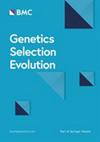Quantitative genetic analysis of late spring mortality in triploid Crassostrea virginica
IF 3.1
1区 农林科学
Q1 AGRICULTURE, DAIRY & ANIMAL SCIENCE
引用次数: 0
Abstract
Triploid oysters, bred by crossing tetraploid and diploid oysters, are common worldwide in commercial oyster aquaculture and make up much of the hatchery-produced Crassostrea virginica farmed in the mid-Atlantic and southeast of the United States. Breeding diploid and tetraploid animals for genetic improvement of triploid progeny is unique to oysters and can proceed via several possible breeding strategies. Triploid oysters, along with their diploid or tetraploid relatives, have yet been subject to quantitative genetic analyses that could inform a breeding strategy of triploid improvement. The importance of quantitative genetic analyses involving triploid C. virginica has been emphasized by the occurrence of mortality events of near-market sized triploids in late spring. Genetic parameters for survival and weight of triploid and tetraploid C. virginica were estimated from twenty paternal half-sib triploid families and thirty-nine full-sib tetraploid families reared at three sites in the Chesapeake Bay (USA). Traits were analyzed using linear mixed models in ASReml-R. Genetic relationship matrices appropriate for pedigrees with triploid and tetraploid animals were produced using the polyAinv package in R. A mortality event in triploids occurred at one site located on the bayside of the Eastern Shore of Virginia. Between early May and early July, three triploid families had survival of less than 0.70, while most had survival greater than 0.90. The heritability for survival during this period in triploids at this affected site was 0.57 ± 0.23. Triploid survival at the affected site was adversely related to triploid survival at the low salinity site (− 0.50 ± 0.23) and unrelated to tetraploid survival at the site with similar salinity (0.05 ± 0.39). Survival during a late spring mortality event in triploids had a substantial additive genetic basis, suggesting selective breeding of tetraploids can reduce triploid mortalities. Genetic correlations revealed evidence of genotype by environment interactions for triploid survival and weak genetic correlations between survival of tetraploids and triploids. A selective breeding strategy with phenotyping of tetraploid and triploid half-sibs is recommended for genetic improvement of triploid oysters.三倍体长春花晚春死亡的定量遗传分析
三倍体牡蛎是由四倍体和二倍体牡蛎杂交而成的,在世界范围内的商业牡蛎养殖中很常见,在大西洋中部和美国东南部的孵化场养殖的珍珠贝中占很大比例。繁殖二倍体和四倍体动物以遗传改良三倍体后代是牡蛎特有的,可以通过几种可能的育种策略进行。三倍体牡蛎,以及它们的二倍体或四倍体亲属,还需要进行定量遗传分析,以便为三倍体改良的育种策略提供信息。晚春三倍体近市场大小三倍体的死亡事件的发生强调了三倍体锦葵定量遗传分析的重要性。对美国切萨皮克湾(Chesapeake Bay) 3个地点饲养的20个父系半兄弟三倍体家族和39个全兄弟四倍体家族进行了三倍体和四倍体弗吉尼亚锦鲤的存活率和体重遗传参数的估算。采用线性混合模型对ASReml-R性状进行分析。利用polyAinv包在R.建立了适合于三倍体和四倍体动物家系的亲缘关系矩阵。5月初至7月初,3个三倍体家庭的成活率低于0.70,而大多数三倍体家庭的成活率大于0.90。三倍体在这一时期的生存遗传率为0.57±0.23。患病部位的三倍体存活率与低盐度部位的三倍体存活率呈负相关(- 0.50±0.23),与相似盐度部位的四倍体存活率无关(0.05±0.39)。在晚春死亡事件中,三倍体的存活具有大量的加性遗传基础,表明四倍体的选择性育种可以降低三倍体的死亡率。遗传相关揭示了环境相互作用对三倍体存活的基因型影响,四倍体和三倍体存活的遗传相关性较弱。建议采用四倍体和三倍体半姐妹的选择育种策略进行三倍体牡蛎的遗传改良。
本文章由计算机程序翻译,如有差异,请以英文原文为准。
求助全文
约1分钟内获得全文
求助全文
来源期刊

Genetics Selection Evolution
生物-奶制品与动物科学
CiteScore
6.50
自引率
9.80%
发文量
74
审稿时长
1 months
期刊介绍:
Genetics Selection Evolution invites basic, applied and methodological content that will aid the current understanding and the utilization of genetic variability in domestic animal species. Although the focus is on domestic animal species, research on other species is invited if it contributes to the understanding of the use of genetic variability in domestic animals. Genetics Selection Evolution publishes results from all levels of study, from the gene to the quantitative trait, from the individual to the population, the breed or the species. Contributions concerning both the biological approach, from molecular genetics to quantitative genetics, as well as the mathematical approach, from population genetics to statistics, are welcome. Specific areas of interest include but are not limited to: gene and QTL identification, mapping and characterization, analysis of new phenotypes, high-throughput SNP data analysis, functional genomics, cytogenetics, genetic diversity of populations and breeds, genetic evaluation, applied and experimental selection, genomic selection, selection efficiency, and statistical methodology for the genetic analysis of phenotypes with quantitative and mixed inheritance.
 求助内容:
求助内容: 应助结果提醒方式:
应助结果提醒方式:


